
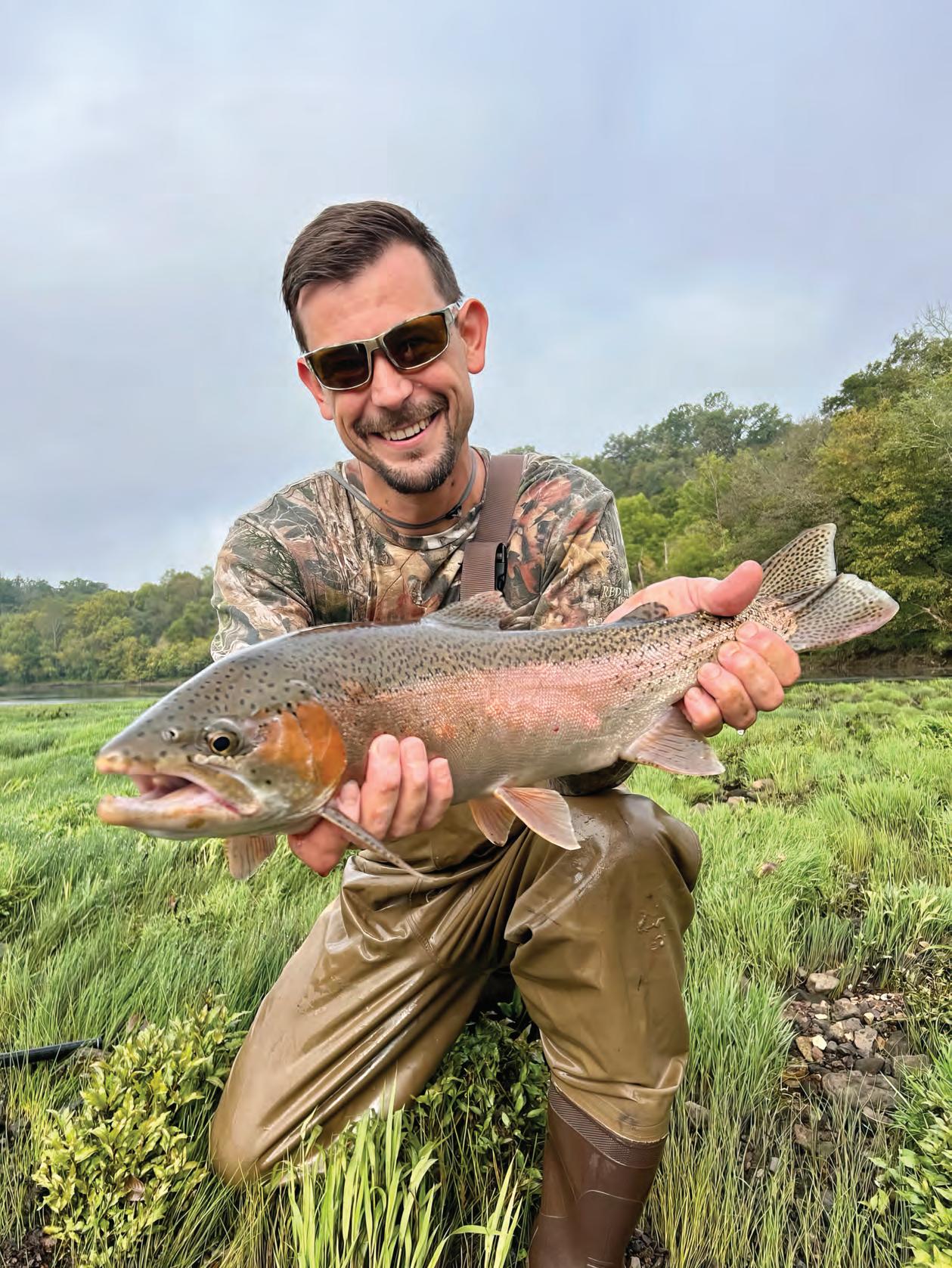

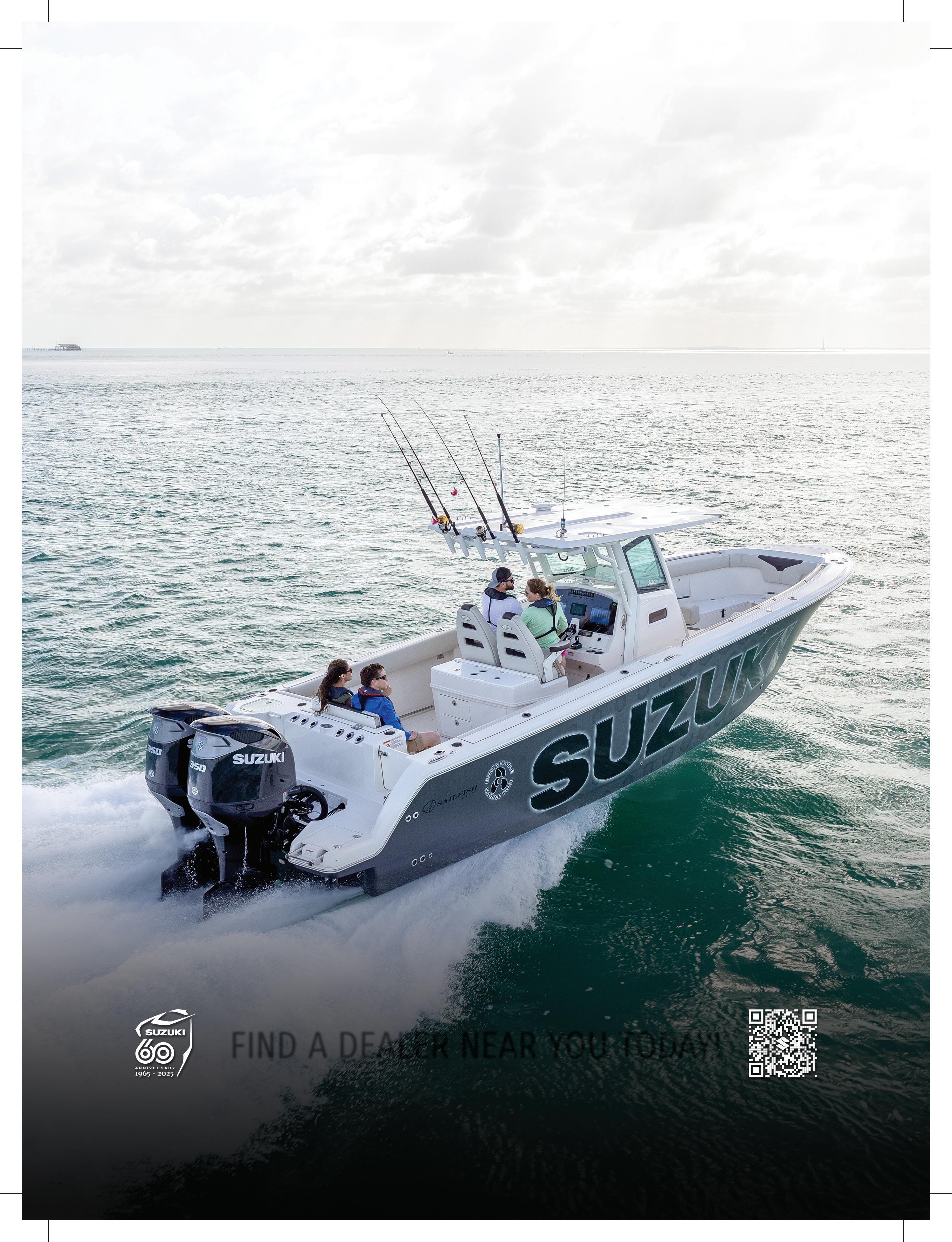







































Ever see a commercial harbor full of Furuno Marine Electronics and wonder why the pros rely on us?





See why here










Are you ready to embark on your next on-water adventure? Before you set sail, here are fve things to know about boat insurance.
1. Boat insurance isn’t just for accidents
With comprehensive coverage, you’ll also be protected fnancially for theft, vandalism, and unexpected events like storms if you need repairs or replacements due to damage.
2. Accidents can happen to anyone
When accidents happen, boat insurance offers liability coverage for damages or injuries you cause while boating, up to specifed limits. It can also cover lawsuit costs if you’re sued.
3. Boat insurance can cover medical payments
Boat insurance offers a range of optional medical payments coverage limits, helping to cover medical expenses if you’re in an accident or someone is hurt on your boat, regardless of fault.
4. Most lenders require boat insurance
If you fnanced your boat, you’ll likely need boat insurance since most lenders require boat insurance to protect their investment. Additionally, some marinas or municipalities require proof of insurance for docking.
5. Progressive offers specialized boat coverages
Ever worry about getting stuck on the water?
Progressive’s Sign & Glide® On-Water Towing coverage** can help. It’s an additional coverage that steps in if your boat is disabled or breaks down on the water, paying for on-water towing, jump starts, soft ungroundings, and fuel delivery. Fuel cost isn’t included.
Don’t let unforeseen circumstances disrupt your voyage. Cruise with confdence thanks to Progressive Boat insurance. Because when it comes to your boat, peace of mind is the ultimate luxury.
Scan to get a quote in as little as 4 minutes.
to learn more.




















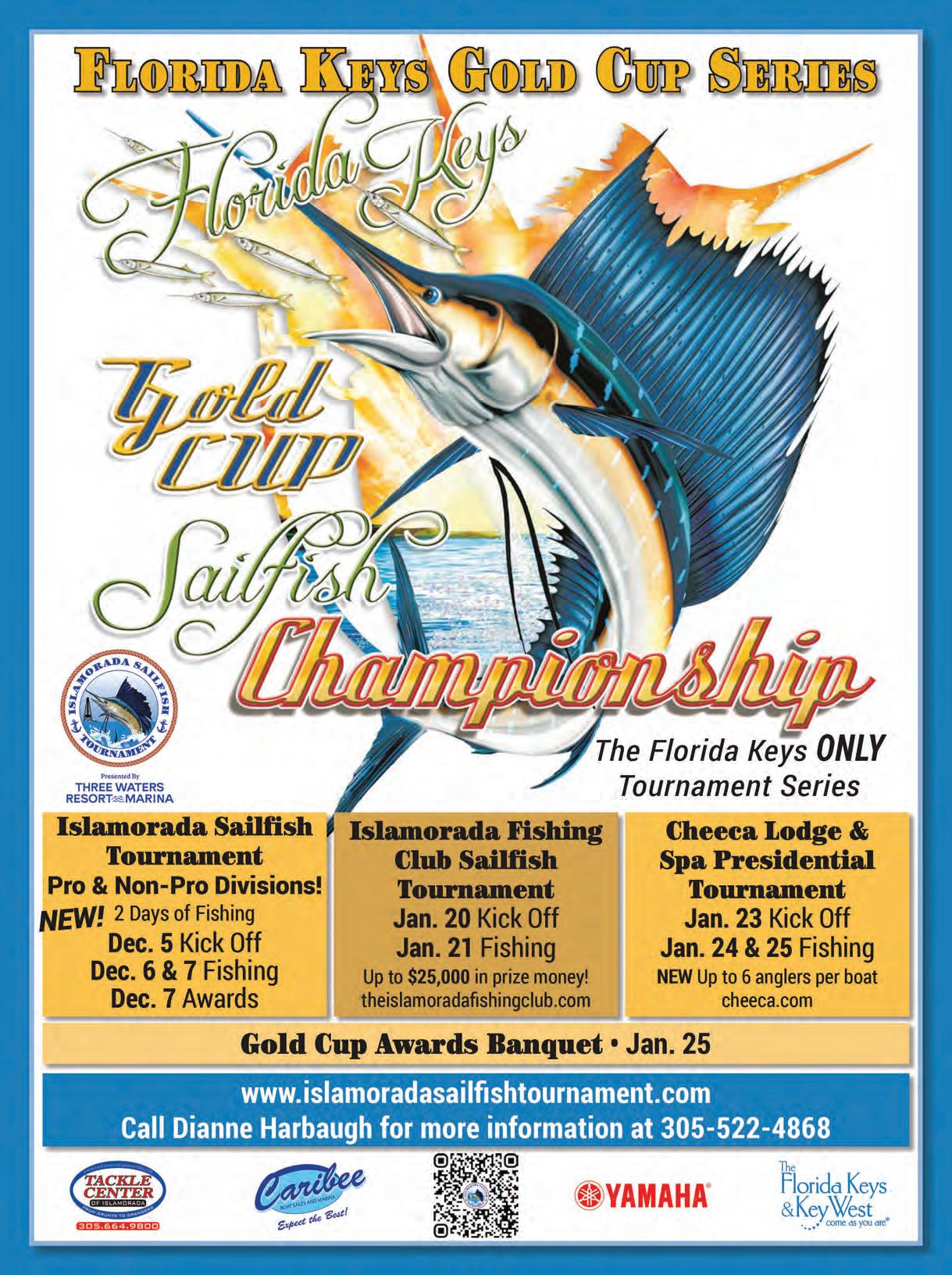


There’s remote, and then there’s Pulley Ridge. Sitting over 100 miles o! the coast of Florida, this underwater plateau is where the Gulf of Mexico drops into the deep blue, and it’s earned a legendary reputation as one of the most productive, and challenging, shing destinations in the U.S.


By Astrid deGruchy
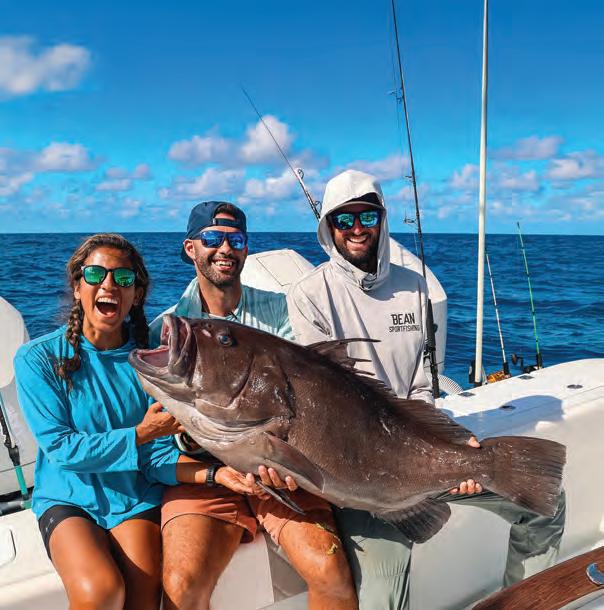

If you’re heading out there, you’ll need a serious o!shore machine. ink a 47’ Freeman or a Viking, something that can handle the long run and unpredictable Gulf conditions. is isn’t a trip for small center consoles or light tackle. Last time we were out there, we loaded up with PENN Fathom electrics paired with PENN Ally Electric rods & PENN International 50 VISX ready to drop into depths that test both your gear and your patience.
Using chicken rigs, we hauled in vermillion and yellow snappers in over 500 . of water that lled the box, but Pulley Ridge has a wild side where giant groupers and the occasional “what-the-heck-is-that” monsters lurk in the dark.
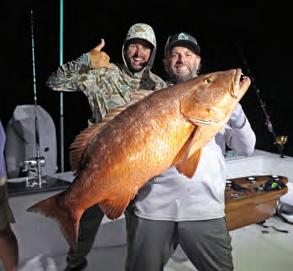
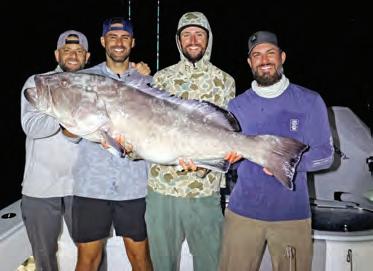
Pulley Ridge isn’t just another shing trip, it’s a rite of passage. e distance, the depth, the unknown, it all adds up to one of those bucket-list adventures every angler should do once in their life, especially with a crew of buddies who live for the chase. While you’re out there, you can even make a stop at the Dry Tortugas, another incredible o!shore destination rich in history and beauty.
Check out the full Pulley Ridge expedition on YouTube, only on Bean Sport shing TV.







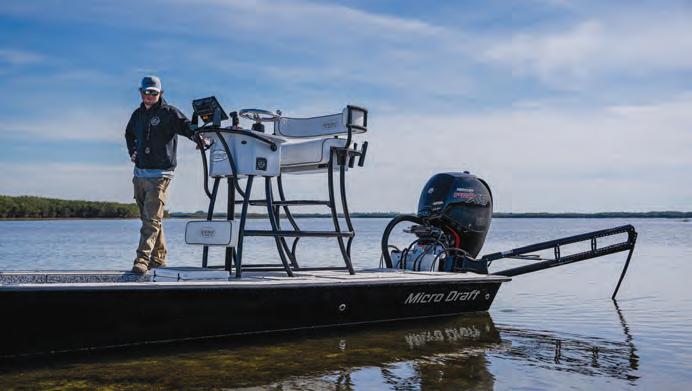





By Julie Graham

The Cherokee National Forest o!ers some of the best freestone trout shing in the Southeast. Spanning 650,000 acres across the Southern Appalachians, it’s the largest block of public land in Tennessee and it’s divided neatly in two by the Great Smoky Mountains National Park.
On the north side, mountain streams tumble through hemlock hollows toward Cosby. To the south, the waters of Citico Creek cut deep through wilderness ridges near the Unicoi Mountains. Together, they showcase the Cherokee’s range. From roadside creeks to backcountry runs, the forest o!ers anglers a taste of freestone Tennessee trout water.
Below the Great Smoky Mountains National Park boundary, Cosby Creek winds through the community of Cosby, Tennessee, o!ering accessible trout
water without the added park permit. ese lower stretches are regularly stocked by the Tennessee Wildlife Resources Agency (TWRA) and can provide productive shing throughout spring and fall. While access is somewhat limited, anglers will nd several bridges and pull-o!s along Highway 32 where they can wade in. e streambed is rocky and slick, with plenty of boulder pockets and undercut banks—good traction and careful footing are essential. Expect stocked rainbows with the occasional brown trout.
Inside the Park, the Cosby Campground section is ideal for bank shing and light wading, especially for those who prefer easy access close to trails and picnic areas. Brook trout dominate the upper reaches, while rainbows hold in the deeper pools below.
To the south, Citico Creek drains more than 20,000 acres of rugged country on the western edge of the Cherokee. Fed by the north and south forks rising in the Unicoi Mountains, Citico o!ers a blend of stocked and wild trout water—ideal for anglers who like a mix of easy access and adventure.
e TWRA regularly stocks Citico from Little Citico Creek to the Citico Creek Wilderness boundary, while the upper forks hold self-sustaining populations of wild rainbows and browns.
e Cherohala Skyway marks the southern edge of the Citico Creek watershed, and just driving it is worth the trip—sweeping vistas, ery fall colors, and the sound of water around every bend.
Autumn is prime time on both sides of the Cherokee National Forest. Water temperatures drop, trout feed hard before winter, and the hardwood ridges turn to ame.
• Match the Hatch: Early fall favors terrestrials; in November, go small with blue-winged olives, midges, and caddis emergers.
• Go Light: Clear, low ows call for 6X or 7X tippet and longer casts.
• Mind the Leaves: Dri leaves can snag a line—look for deeper pools below ri&es where trout hold under cover.
• Start Late: Cooler nights mean shing o en improves mid-morning as the water warms slightly.
For more information, including licensing regulations, visit the Tennessee Wildlife Resources Agency at https://www.tn.gov/twra.html.


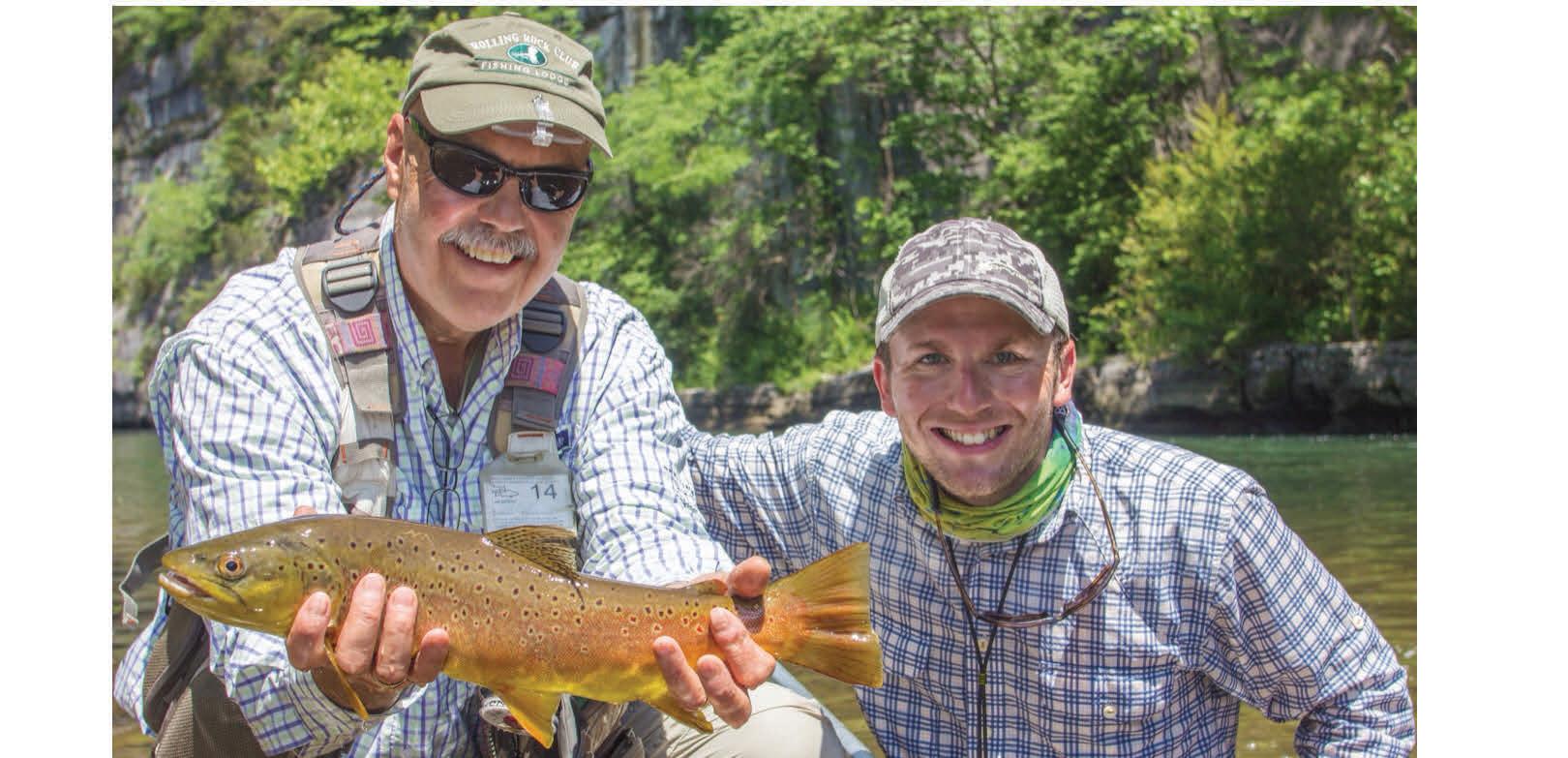































































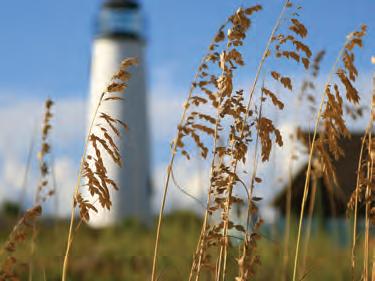








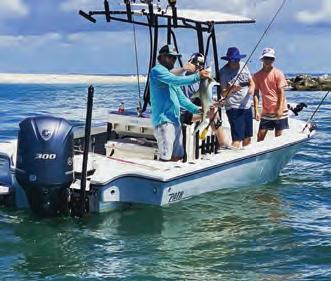






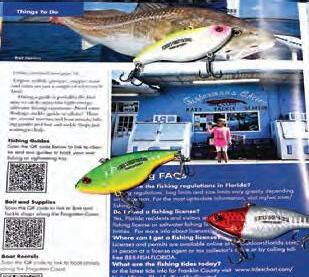












By Bucky Buchstaber
When I first asked myself the simple but powerful question, “What do I have in my hand that can do good in the world?” I was holding a fly rod. That moment marked the humble beginning of what would become Fly Fishing Collaborative (FFC) — a nonprofit organization that today mobilizes the global fly-fishing community to combat human trafficking and poverty through sustainable, life-changing solutions.
What started as a personal conviction and a fly rod has grown into a worldwide movement, using the passion and generosity of anglers to bring hope, food security and protection to some of the world’s most vulnerable populations. The mission of FFC is as clear as the waters its community wades in: Fish well. Do good.
At its core, we exist to connect the love of fly fishing with a greater cause. While casting dry flies to rising trout may seem worlds away from the battle against human trafficking, FFC proves that beauty, adventure and justice can intersect.
Human trafficking is often fueled by a lack of options — particularly in the form of food insecurity. According to UNICEF, food scarcity is among the top drivers of human trafficking globally. Desperation leads families and children to fall prey to the false promises of traffickers, who exploit the vulnerable under the guise of opportunity.
Recognizing this root cause, FFC took action in a way that reflects the spirit of the fly-fishing community: creatively, sustainably and relationally. FFC’s flagship initiative is the building of sustainable aquaponic farms —


systems that combine fish farming (aquaculture) with vegetable cultivation (hydroponics). These farms provide a consistent source of protein and produce, empowering safe homes, orphanages and rural communities to feed themselves, generate income and reduce vulnerability to trafficking. To date, FFC has built aquaponic farms in more than 10 countries, including Kenya, Thailand, the Dominican Republic and Belize. Each farm is tailored to the needs and climate of the community it serves. These are not handouts; they are hand-ups, designed to offer longterm stability and independence. One farm in Southeast Asia supports a home for kids rescued from brothels and sex trafficking rings, providing not only food but also therapeutic work and vocational training. Another, in a remote African village, serves an orphanage that helps prevent children from falling victim to traffickers in the first place. These are places where food becomes more than sustenance — it becomes freedom. Fly fishers are no strangers to patience, persistence and care for the environment. FFC taps into this spirit, inviting guides, outfitters, fly shops and anglers to become advocates for justice through fundraising expeditions, gear collaborations, awareness campaigns and, I’m happy to say, Fly Fusion’s Trout Tour.
FFC turns passion into action and is excited to take part in this year’s Trout Tour in our “Fish Well. Do Good.” segment. The film tour brings together breathtaking cinematography, meaningful narratives and the shared love of fly fishing. Our two films in the tour capture the essence of what FFC is all about: fishing well and doing good.
This is not about charity for charity’s sake. It’s about partnership, dignity and creating lasting change through mutual respect and collaboration. Every product sold, every guided trip that donates a portion of its proceeds, and every film screened in the Trout Tour adds another drop to a growing ripple of impact.
And it all started with a simple question.
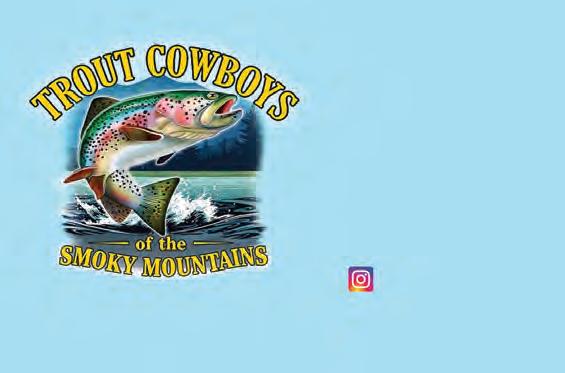

By Jim Mize
My daughter named this hole. I was sitting back in the woods watching her cast repeatedly to a twenty-inch rainbow, and all the while it refused her offering she was muttering under her breath, “Hateful, hateful, hateful.”
The Hateful Fish Hole, in case you lack good sense and want to fish there, lies on the upper end of Humility Creek, the stream where hemlocks crossed with Venus flytraps consume enough flies to keep the local fly-tackle shop in business. The fish on this stream are said to sport rearview mirrors, so regardless of your direction of approach, they take off with a wave of their tails.
The Hateful Fish Hole looks like any other nondescript flat run, with a riffle at the top and a small ledge at the bottom that brings the flow to a stop before plummeting three feet into the next hole. Only hip deep at its deepest point, in this hole the fish usually can be seen lined up in a feeding lane that ranges from the bottom to the top, parallel to the flow. Bump one fish and he bumps the next, who bumps the next until all have gone to hide.
My daughter can fling a fly with the best of them and knows enough about bugs and branches to guide edible flies through the overhangs on Humility Creek and catch these wild trout. Upstream or downstream, rainbows or browns, the fish fall to the temptations she floats past them. It’s just this one hole that won’t share its fish.
On this particular day, she had tried an assortment of flies from small caddis to stonefly nymphs, only to have trout inspect her offering and politely decline. All during this episode, I could see fish rise to
sip midges, open their mouths underwater in a flash of white, or roll sideways to nudge a nymph loose.
After she had flailed to her dissatisfaction, I eased into the hole and tried a tan caddis with a midge dropper, usually the ticket for picky trout in these parts. Rainbows would rise to look, drift backwards with the fly, then settle into their original positions. After a while, they didn’t even rise to look.
I went through my box of tricks to see what else I could drift past these masters of indecision. Considering the possibilities, I first thought that maybe my midge was the wrong color. But how can you spot the color of an insect too small to see? We had already drifted larger flies and I had presented my smallest flies, both with the same result.
We concluded that these trout were just hateful.
Whenever we fish this stretch of Humility Creek, we give extra effort to the Hateful Fish Hole. It’s become a challenge, knowing that if we can catch these fish, we can catch any fish.
Last fall, on an afternoon when the browns were battering a Foxee Clouser, I came to the Hateful Fish Hole with renewed confidence. After all, I’d had enough luck already to almost lose my humility and replace it with confidence.
At the head of the pool, the last storm had pushed a log into the hole and wedged it against a boulder on the far side. The gorge in these mountains channels an inch of rainfall into a foot of stream flow, so the debris gets rearranged with every major storm. With that log providing cover, any big brown holed up here would lie in its shadow. So I drifted
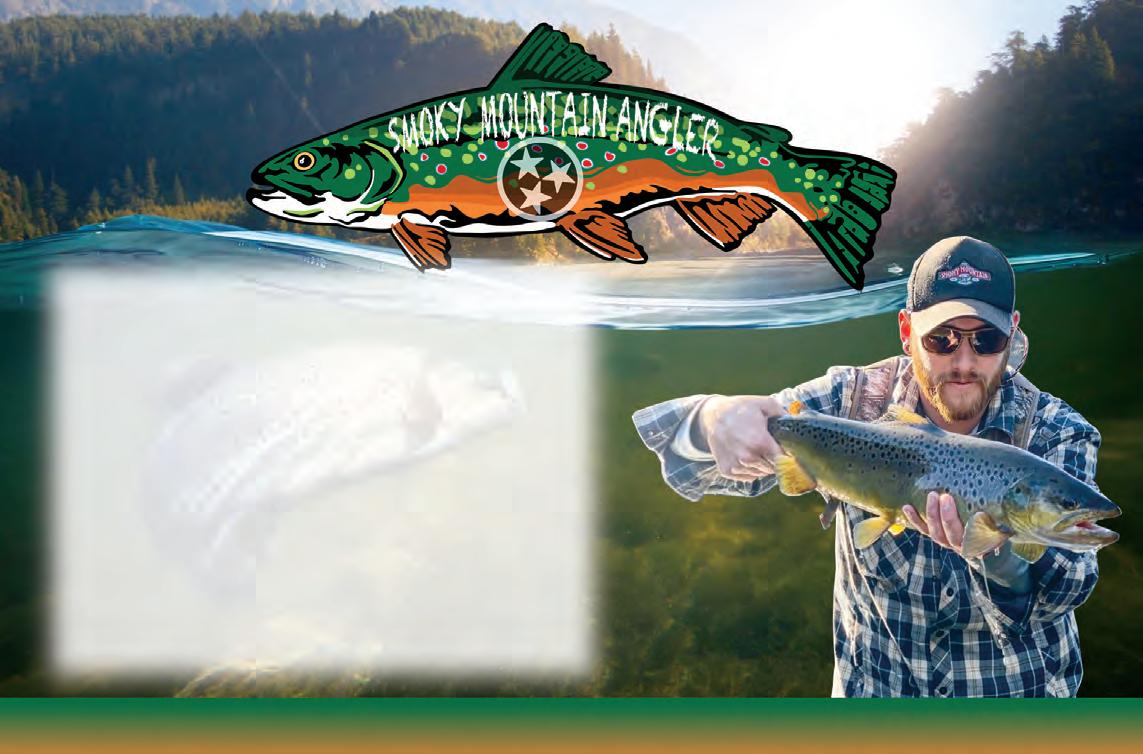
the Clouser a breath off the log and without hesitation the brown rolled on the fly.
He just didn’t take it.
It looked like one of those football drills where linemen jump over each other while another one rolls under them. The fish rolled over the fly, flashed that big bronze belly at me, and came down on the other side of my line with no fly in its mouth.
I set the hook, sent a perfectly-good Clouser into the hemlock behind me, which took it in one big gulp and I swear I heard it belch. The brown went back into his ambush spot in the Hateful Fish Hole and waited for the next unsuspecting fisherman.
During the dark hours of the night, I often ponder the secret to the Hateful Fish Hole. I tie ever-smaller midges in various colors, plot approaches to stay more concealed, and constantly buy smaller Fluorocarbon tippet every time a new brand comes out. I concluded that I needed to wait them out, wait for the perfect season, the perfect water, and the perfect weather. Then, this week it came.
Late in the summer, Humility Creek gets a little warm and the water a little low. So I leave the fish alone until the nights cool. Then, if a piece of a tropical storm breaks off, we can get several days of back-to-back drizzle. Not enough to muddy the water, just enough to perk up the fish. Give them a good dose of oxygen and a few more inches of current to hide in.
So when that storm came, I took off and headed to the Hateful Fish Hole.
Using the stretch downstream to fine-tune my offer, I found the browns most receptive to an inchworm. I tie a small one with a curled tail and it looks like it just fell from the sky. Maybe my tippet passes for its web, but the browns strike like they haven’t had a meal since spring. I had already released a handful of browns and rainbows when I had fished my way up to the hole. I watched it before moving in to see if any
fish were active. On this day, nothing moved.
I tried the tail of the hole first to avoid bumping any browns that had moved into the shallows to feed. Three quick casts, left, center, and right of the stream flow produced nothing.
Up near the boulder, subsequent storms had taken the log downstream, so the most likely spot now for a big fish was behind the rock and under a mountain laurel branch. I carefully worked about fifteen feet of line and twelve more of leader side-armed to keep it low and landed the inchworm with a noticeable “kerplop”, just the way browns like it. Before the rings could expand, a brown pounced and I set the hook.
To my amazement, the brown actually was on my line, in the Hateful Fish Hole, just like any other fish and hole. Maybe the curse was broken.
Or maybe not.
The brown took off on a tear toward me at the lower end of the hole. On the opposite bank, brush had piled up and the brown streaked toward it. I leaned into the three-weight and 6X-tippet as much as I dared, but knew I would be better off risking a broken line than letting that fish get into the brush.
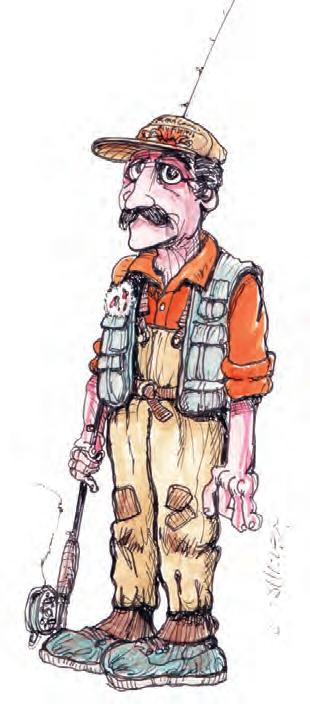

Even with his head of steam I managed to turn him enough to skirt the brush pile and as soon as I did, I discovered it had all been a ruse. He never meant to go into the brush. Instead, he immediately dived under a flat rock. This rock looked like any other part of the stream bed, flat, three feet across, and at first glance, flush with the bottom. There couldn’t have been more than a couple inches of clearance on the back side but he squeezed in with my line scraping over the top. I tried pulling him out but he found a hold and I couldn’t.
Not wanting to lose my first hateful fish, I waded out to get an angle from the back side and pry him loose. But by the time I got there, he’d found some leverage on tippet or fly, worked it loose, and made his departure just as I got there.
From where I stood, his tail seemed to wave good-bye.
So in the wee hours when it’s quiet and dark, I still plot strategies for the Hateful Fish Hole. I will keep buying smaller tippets with each new technological breakthrough. I will track my fishing log for hatches and stream conditions to plan the time of attack. And maybe I will come up with a different color midge that a trout with good eyesight can’t resist.
But on a creek that teaches humility, hateful fish are master instructors.
“The Hateful Fish Hole” is an excerpt from the award-winning book, A Creek Trickles Through It. You can order copies online or purchase autographed copies at www.acreektricklesthroughit.com, Jimmize1@cs.com
Award-winning author, Jim Mize, has written a humorous book specifically for fly fishermen. Titled, A Creek Trickles Through It, this collection delves into such topics as carnivorous trees, persnickety
trout, and the dangers of fly-tying. This book was awarded first place in the Southeastern Outdoor Press Association’s Excellence in Craft competition. Whether you are an armchair fisherman or one with well-earned leaky waders, it will be a welcome addition to your fishing library.

Jim has received over one hundred Excellence-In-Craft awards including one for each of his other books including The Winter of Our Discount Tent, Fishing With Beanpole, Hunting With Beanpole, and The Jon Boat Years. His articles have appeared in Gray’s Sporting Journal, Fly Fisherman Magazine, Fly Fishing & Tying Journal, as well as many conservation publications. You may order copies through Amazon or get autographed copies from his website at www.acreektricklesthroughit.com
I never imagined that my fly rod would be the tool that helped build fish farms, fund safe homes and rescue children. But that’s the power of asking: “What do I have in my hand that can do good in the world?”
Maybe it’s a fly rod. Maybe it’s a camera, a business, a platform or a skill. FFC’s story invites us all to consider what we’ve been given — and how we might use it to bring life, freedom and hope to others.
So the next time you tie on a fly, step into a cold river or share a story at the fly shop, remember this: You can fish well. And you can do good.

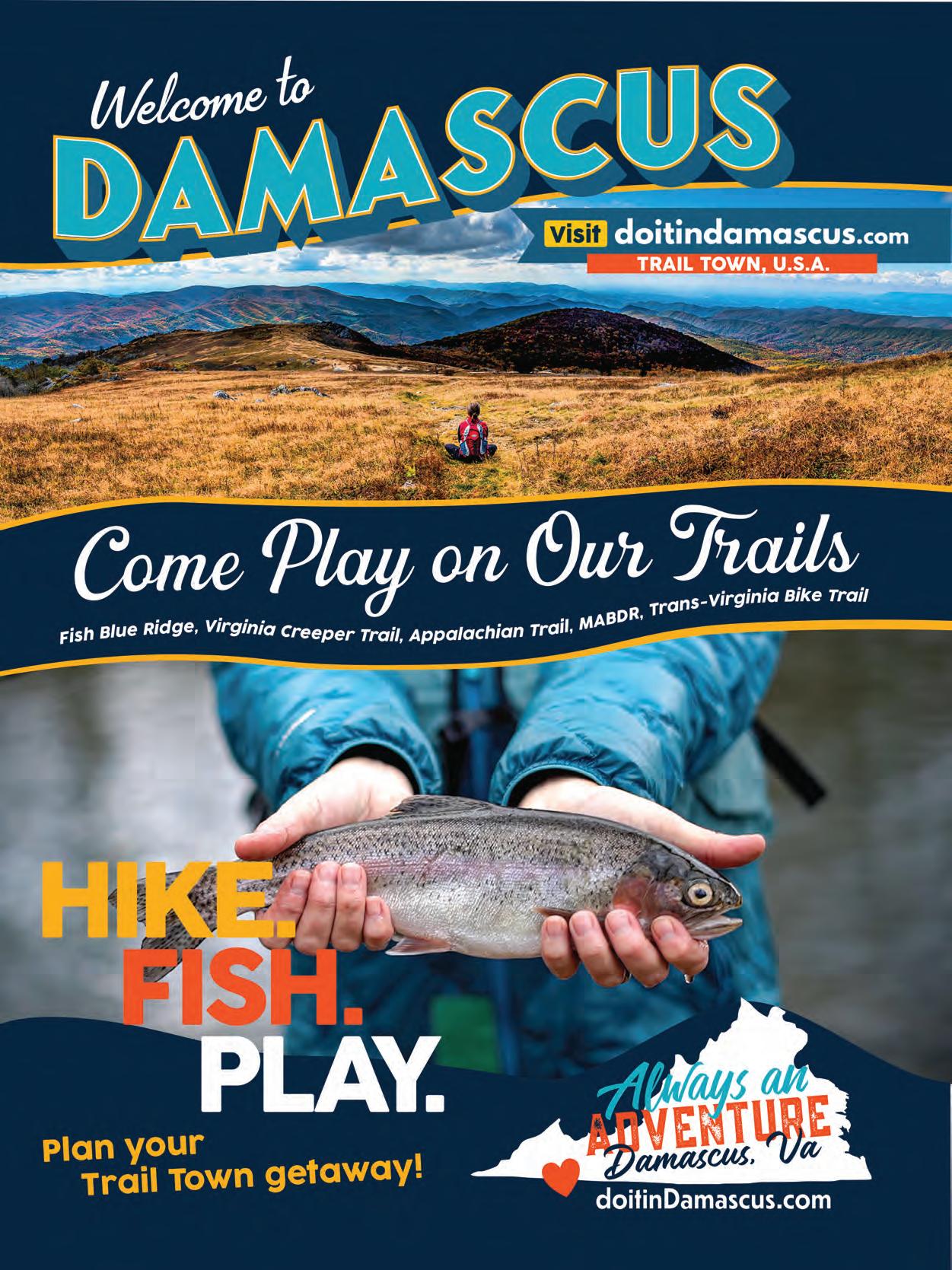
Provided by Captain Jim Durham, Owner StriperFun Guide Service, Tennessee and Kentucky Walleye, Bass, Crappie and Muskie Charters, Superbaittanks.com, Captain Jim Marine Electronics and much more…… Date of report: November 2026
Greetings to my readers! I hope the world finds you and your family doing well!
The fall striper fishing on Lake Cumberland (southern KY) is terrific, with limits of nice 10-to-15-pound stripes caught on many days and the occasional 20 pounder as well! We troll live bait on planer boards 10 to 30 feet deep concentrating on main creek channel points. We also cast and troll Captain Jim “Striper Magic” lures. With multiple full-time guides, StriperFun offers day trips on Lake Cumberland year-round (weather permitting).
The striper–hybrid fishing on Cherokee Lake (near Knoxville, TN) is very popular with our clients. Throughout the fall we troll live bait on planer boards 10 to 30 feet deep and also downline on suspended schools of fish, concentrating on main lake creek channel points. Beginning in December we then troll Captain Jim umbrella rigs!
The striper and hybrid fishing is simply off the chart! 20 and 30 fish days are frequent. (TN allows catch and release!) With multiple full-time guides StriperFun offers day trips on Cherokee Lake year-round (weather permitting).
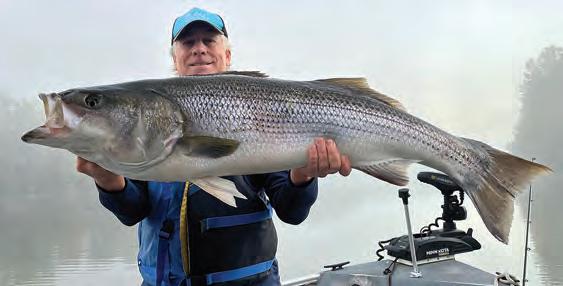
As we are coming into November, the cool weather causes the bite to get even better! As the weather begins to cool, the “monster” stripers begin to fatten up! We use live 3-pound trout as bait! With multiple USCG licensed guides to provide charter services for our clients, fall on the Cumberland River annually is a great time to fish!
We begin each fall sauger—walleye fishing on the Cumberland River (north central TN). Our techniques include jigging live bait and trolling with a variety of lures. These trips begin in late November and run through March 31st. The fishing is phenomenal.
All of these above trips book up in advance! Get your trip booked today!
It is great to be alive and be a “free” American! I look forward to seeing all of you this year on the water. Always remember to stop and shake the hand of a person in uniform or wearing garb that shows they are a veteran!
Continued, see CAPTAIN JIM Page 24
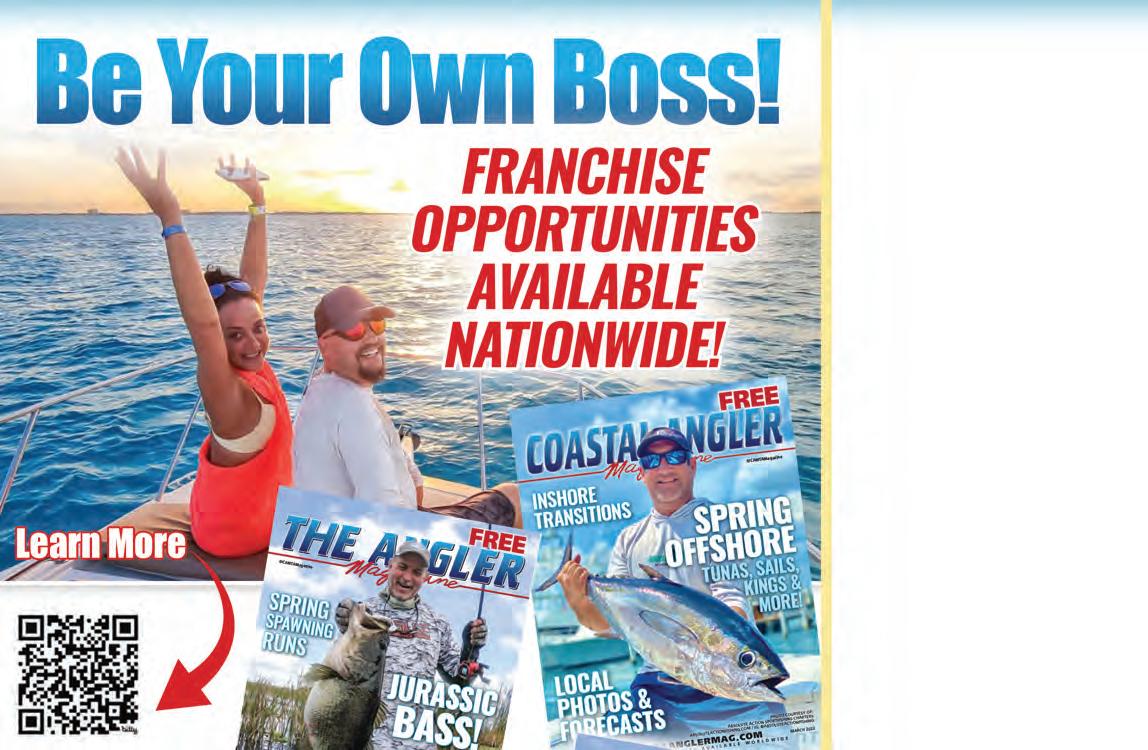
If you love the outdoors and dream of being in business for yourself–but not by yourself, now is the perfect time to make a change and choose a Coastal Angler or The Angler Magazine Franchise.

woody@theanglermagazine.com coastalanglermag.com/great-smoky-mountains

By Matt Xenos & Perry Hensley
Yesterday could not have been a better day to hold an event. It got a little warm in the afternoon, but a beautiful day all around. We had 14 boats enter the event and all 14 weighed in a limit of fish. Most teams reported catching fish all day long with lots of teams stating catching over 100 during the day.
Tellico Lake has got a lot of crappie in it. However, the lake does not produce many big crappie. Could be many things playing a role into that. Sheer population, being fed by very clean clear mountain water from the two supporting rivers, or lack of bait to produce growth rates. Either way, it is a fantastic lake to catch lots and lots of crappie.
The winners on this day was the team of Trey Helms and CH Thomas with a 7 fish bag weighing in at 7.21 Lbs. Congrats gentlemen!
2nd Place and Winners of Big Fish went to the team of Ray Pratt and Jimmy Pratt with a bag of 7.08 Lbs and a Big Fish of 1.80 Lbs. Good job men.
In 3rd Place was the team of Chris Henson and Eric Lawson with a bag of 6.79 Lbs. Awesome sack fellas.
Our ACC Crappie Stix roll the dice winners of the two ACC Crappie Stix was the team of Josh Sanders and Matt Xenos.
Winning the roll the dice hats and slab bites was Chris Sims and Josh Sims.
Winners of the Bone Head Tackle roll the dice baits was the team of Ryan Coffelt and Ty Coffelt.
The roll the dice winners are chosen by and actual roll of the dice.
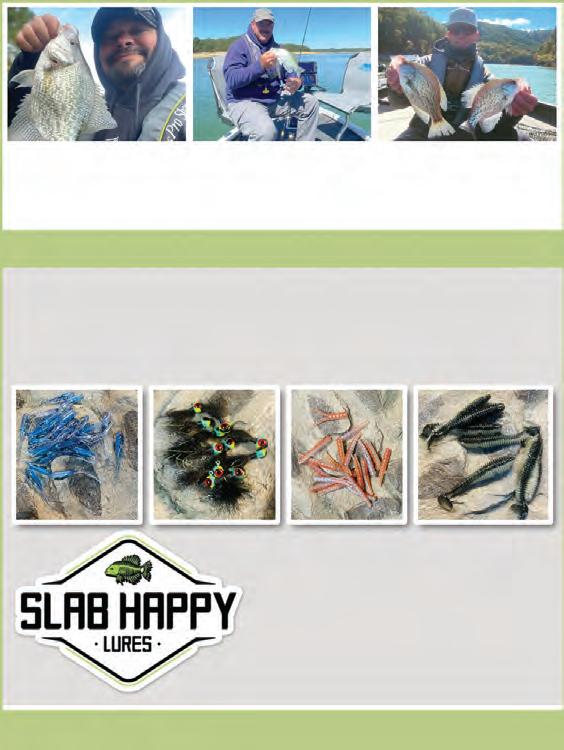

Trey Helms and CH Thomas took the big win with a 7 fish bag weighing in at 7.21 Lbs.
The corresponding place on the leaderboard wins the prize. Stipulations are you have to be present at the weigh in, have to have weighed in a fish, and cannot have finished in the money.
Our next event will be October 18th on Ft Loudon Lake and we will be launching from the Ish Creek Boat Ramp. Hope to see you all then!!

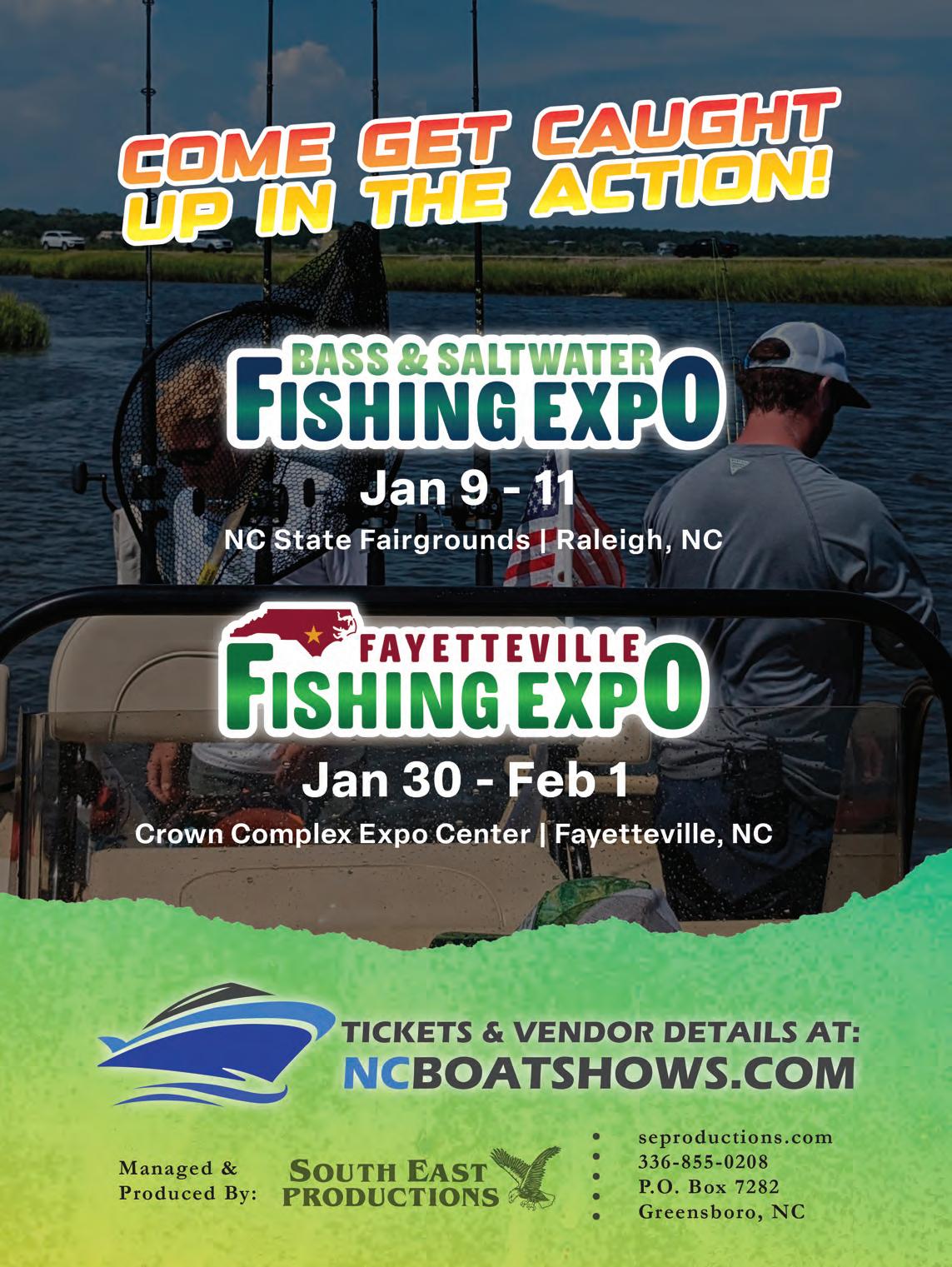
Enjoy fall festivities on the farm, including hayrides to the pumpkin patch, interactive corn maze, hay maze, autumn treats, and more! Darnell Farms is a true agro-tourism experience for the whole family. We are in a beautiful valley along the banks of the Tuckasegee River in Bryson City, North Carolina.
We’re an active, second-generation family farm. Our farm produces 100 acres of strawberries, pole beans, sweet corn, pumpkins, squash, a variety of tomatoes and much more.
Darnell Farms’ passion for farming sprang from the patriarch, Jeff Darnell’s, passion for land preservation. During the 1970’s in Western North Carolina, there was an interesting boom in land sales for development. While this added population to the rural area, it also took out beautiful and viable farmland, which was already few and farbetween in these Southern Appalachia’s. Finding nutrient rich valleys located amongst water was becoming increasingly difficult, as people began building on precious land. Jeff Darnell decided as a young man that he was going to counteract the booming build for selling off the
farmland, and he started farming every piece that he could. Today, the Darnells farm over 100 acres of precious farmland in Western North Carolina, all while working towards putting their farmland into Agricultural Preservation Programs through Mainspring Conservation Trust- ensuring that the land stays farmland for generations to come. We have several festivals throughout the year. In addition, we host special events and activities for various organizations in our area. We also offer educational field trips to our farm. During our field trips we love sharing information about farm life, methods used to raise our crops, and how to be good stewards of our precious land. We even discuss the history of the lands we farm, including the ties to the Eastern Band of Cherokee Indians, who are literally our next-door neighbors. Our mission is to educate, protect, and influence the preservation and understanding of Appalachian Agriculture in the Great Smoky Mountains of Western North Carolina, by making our working farm a memorable experience for everyone.



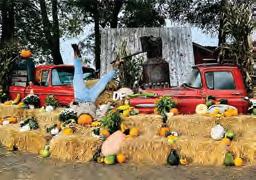

By Scott Norton
Fall is one of those special seasons, much like the spawn. Bass will be gorging right now to feed up for those cold winter months. When those nights start getting cold, their instinct takes over and their metabolism ramps up. Bass will start to school and work together to corral forage so that feeding is efficient and effective. You will notice a change in pattern from week to week. Some lakes start sooner than others because of elevation and that is why fishing in the mountains is so special. You can choose to prolong a season or end it faster based off of your strategies in the elevation game.
Let us talk baits. This is the season where all baits will work. It is a perfect mirror of the spawn season. If you ever wanted to turn someone on to fishing the fall is the best time for that. There is no question if they are feeding the question is what bait do you want to catch them on. You can choose to use your favorite bait or you can try something new and work on your confidence. You can fish fast or slow it does not matter. Those bass are hitting anything that moves. I still love those topwater bites especially now. I also have a blade bait tied on as well. When shad gather real thick you will have to compete for the attention of those bass. Something with a blade is always going to stand out. Be sure to match the size of the shad in the water and that will also carry over to baits that do not mimic a shad.
When the fall pattern starts they will start hanging around what’s left of healthy grass and when that dies out they hang around hard cover. The deeper the season goes you will see them school up and start to work together to corral shad in the pockets. Some are in the backs of creeks where they are easy to trap. You will also encounter those blowups where

your walking baits will work great.
If you are new to the sport you will need to prepare for the morning chill and the hot afternoons. Dressing in layers is a good way to stay comfortable. Not all people can own the best gear to wear but having a knowledge of the weather patterns will help you know how to plan out your day. You will want to stay as long as you can. I hope that helps, it’s time to fish.
Scott Norton is a Western North Carolina native. Born in Asheville, N.C., he is a long-time hunter, angler and weekend warrior.


By Tom Champeau, Pisgah Chapter of Trout Unlimited
In western North Carolina, federal and state fisheries biologists are working hard to provide trout populations that support recreational fishing while protecting stocks of wild rainbow (originally from the Pacific Coast), wild brown trout (originally from Europe), and wild, native eastern brook trout. In North Carolina, brook trout are the only native species of the family Salmonidae, which globally includes salmon, trout, char, whitefish, and grayling. Brook trout are a species of char, and descended to the southern Blue Ridge during ice ages over the past million years. Over time, brook trout have genetically-diverged from ancestral populations and the Southern Appalachian Brook Trout (SABT) is considered a unique strain.
Recent studies of brook trout from across their native eastern North American range show populations within particular watersheds exhibit further genetic differences. The most up-to-date and comprehensive study was published in 2022 in the Transactions of the American Fisheries Society This study was authored by 18 scientists from all over the country including Great Smoky Mountains National Park (GSMNP) fisheries supervisor, Matt Kulp, and North Carolina Wildlife Resources Commission (NCWRC) trout research biologist, Jake Rash. This study used the latest technology in genetic research, sampled 836 brook trout populations (over 20,000 fish), and involved dozens of laboratories and hundreds of geneticists, biostatisticians, scientists, technicians, and volunteers.
This research reveals that many populations of SABT are small and isolated in high elevation streams which makes them vulnerable to extinction from floods, drought, changing climate, in-breeding, environmental degradation, and pathogens. The map shows were populations of most conservation need are located. This work will help inform fisheries biologists to manage and conserve trout in the GSMNP, Pisgah and other national forests, and state-managed landscapes.
While this and other scientific research reveals many serious threats to the sustainability of SABT, one finding can be considered good news and rather surprising considering the landscape alterations brought on by unmanaged timber harvest during the 19th and early 20th centuries. It was in response to declines in native brook trout that wide-spread stocking of hatchery-produced rainbow, brown, and brook trout occurred.
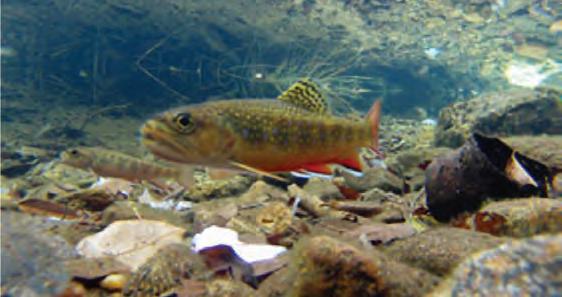
These findings indicate that despite an extensive history of stocking, many SABT populations show little evidence of hatchery introgression (hybridization). The authors state, “the vast majority of populations retain genetic characteristics distinct from hatchery strains.” This may
provide a glimmer of hope that SABT survived massive landscape alterations, and co-existed with stocked fish for over a hundred years yet still retain a high degree of genetic diversity across populations. However, within individual SABT populations, genetic diversity is often critically low, and poor genetic integrity within many populations lowers their sustainability.

Federal and state fisheries biologists are using genetic information to implement projects to restore SABT in streams in the Southeast. Restoring SABT requires the removal of existing rainbow and brown trout by repeated electrofishing or by the application of chemical toxicants. After the existing non-native trout have been eliminated from a high elevation stream (above 3,000 feet), SABT that express high genetic diversity are transferred from nearby streams. Stream sections selected for restoration flow above a barrier such as a waterfall to prevent re-introduction of nonnative trout.
Since the early 2000’s, NCWRC stocks only triploid trout to prevent genetic introgression (hybridization) with wild populations. Triploid fish have three sets of chromosomes which makes them sterile. Chromosomes are long strands of DNA that comprise all the genes that program the production of proteins that make life possible. Most plants and animals have two sets of chromosomes and are called diploid. A scientist at the University of Oxford named Har Swarup first produced triploid fish in 1956. Today, hatcheries across the world use various methods to create triploid fish.
After fertilization of mature eggs by male sperm in a hatchery, technicians apply either pressure, heat, or cold-shock at just the right time to force eggs to retain three sets of chromosomes. The young fish produced develop just like diploid (the normal two sets of chromosomes) fish, but they cannot produce viable eggs or sperm of their own.
While triploid fish cannot reproduce, scientists believe that many millions of years ago, Salmonids branched off through a rare genetic event called whole genome duplication (WGD). Instead of having two sets of chromosomes (diploid), a small percentage of individuals within a population were produced with four or more sets (polyploidy), and an

RALEIGH, N.C. (Sept. 23, 2025) — Just as many lives, businesses, landscapes and wildlife were impacted on September 27, 2024 by Hurricane Helene as it ravaged through western North Carolina, one of the North Carolina Wildlife Resources Commission’s (NCWRC) fish hatcheries, the Armstrong State Fish Hatchery in McDowell County, was nearly destroyed.
“Thankfully our amazing staff survived and are safe,” said Hatchery Production Supervisor David Deaton. “But there was major damage to the facility from the flooding and landslides. Over 600,000 hatchery fish died which severely impacted our trout production capabilities.”
Armstrong has been temporarily closed while repairs are being made to damaged infrastructure and facility roads, and while clean up from debris deposition continues.

“We have been working with contractors and engineers to repair the damage and restore operations,” said Deaton. “Repairs were prioritized and completed in ways that allowed for partial operations in the spring for a somewhat normal stocking of Delayed Harvest and Hatchery Supported waters this year.”
Armstrong State Fish Hatchery is anticipated to be fully operational by November.
A planned renovation project at the Bobby N. Setzer State Fish Hatchery, NCWRC’s largest trout-producing facility, was paused until Armstrong is fully operational. Armstrong is slated to increase its normal production and provide additional support to the trout hatchery program while Setzer closes for renovations. With Armstrong coming back online, the renovations at the Setzer hatchery should begin by January 2026.
In 2024, the N.C. General Assembly appropriated $20 million to NCWRC to be matched with $19.5 million in agency funds for major renovations at Setzer to address aging infrastructure and to provide safeguards from future flooding. Setzer has been in operation since the late 1950s, originally as the Pisgah National Fish Hatchery. NCWRC has operated it as a state fish hatchery since 1983, and it is the agency’s largest of the three trout hatcheries owned and operated by NCWRC.
“Setzer has failing infrastructure that needs replacement before a potentially major failure,” said Deaton. “The project will take a couple of years to complete, and the hurricane delayed that project a year. But through our mountain waters program, we continue to manage both wild and our stocking program, to provide a robust trout fishing experience that is a legacy to our state.”
Trout fishing provides a $1.38 billion impact to North Carolina.
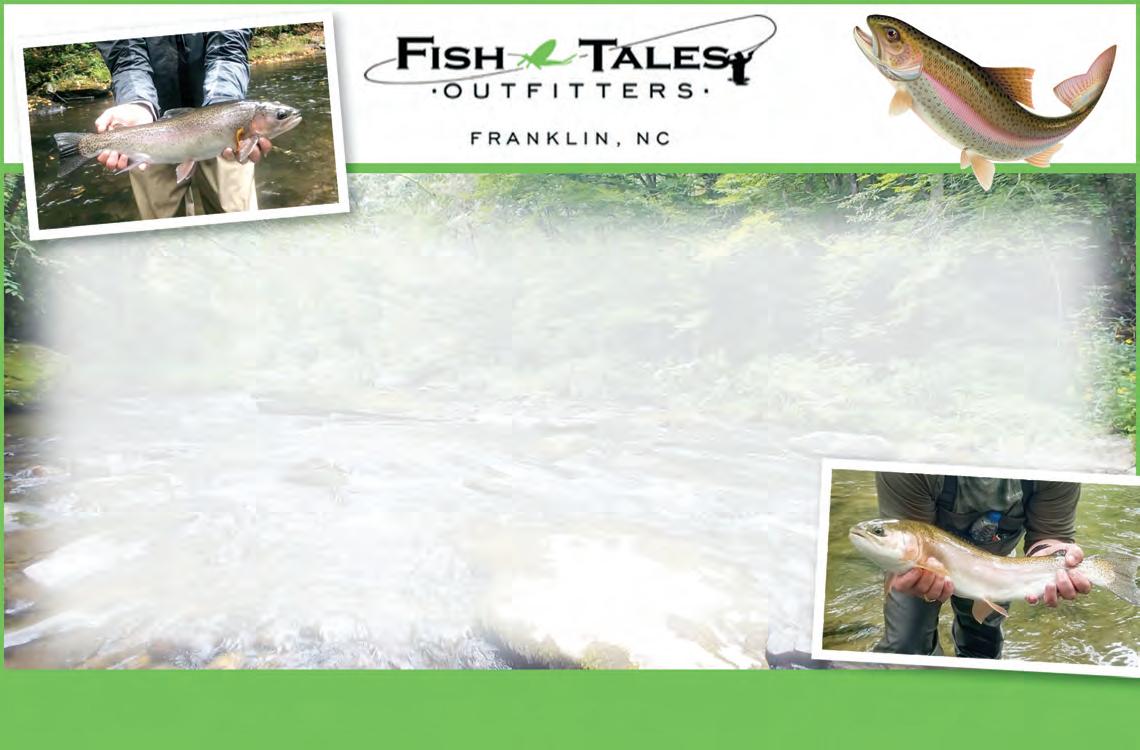

By James McManus
Iknow there is a lot of controversy in bass tournament circles over live scope type technology. Since adding it to my boat, I use it differently than most anglers. Guiding means trying to put folks on fish and with varying angling abilities (or the lack of,) and trolling is the best solution and least stressful for most folks. My unit is mounted on my trolling motor, so while trolling I simply turn it backwards and watch my spread in real time. It is amazing what you find in the way fish react to baits. Deep water trolling this time of year means contour trolling around 40 to 70 feet. Our spotted bass are in schools, usually laid up on the bottom chilling. At Fontana there is so much bait with threadfins and blue backs they are

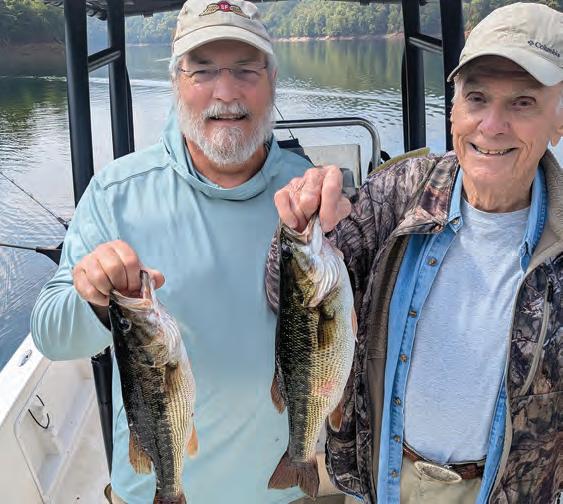
never stressed to find meals. Watching both traditional sonar and live scope it’s amazing how often a few fish on sonar turn into a hundred or more on live scope.
We’ve been hitting points and mark a few fish on sonar, and when our
Continued, see LIVE SCOPE Page 22
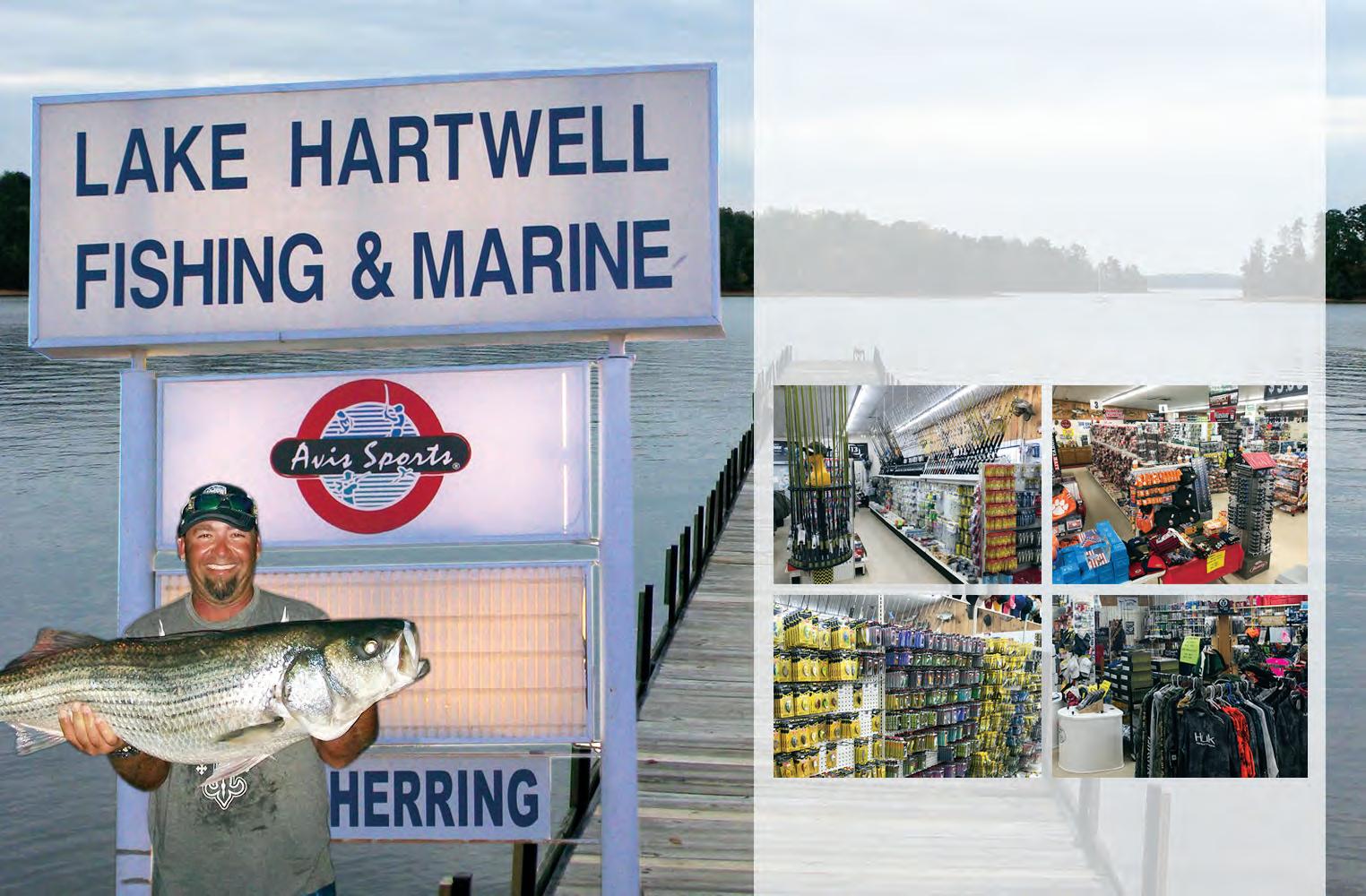





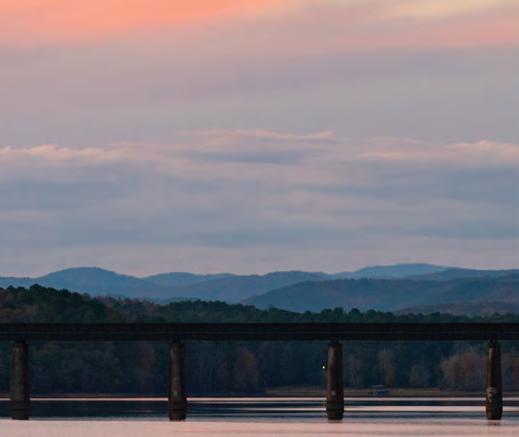

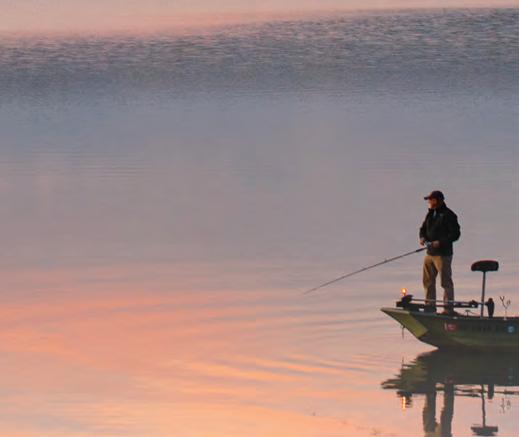




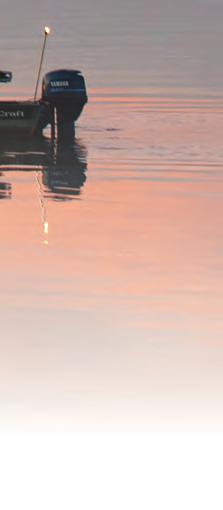
By Capt. Cefus McRae
Most of us probably have a Bucket List, things we want to do, see or experience before we’re too old to do them. For some it might be jumping out of a perfectly good airplane and floating to the ground under a silk canopy. For others it could be seeing the sunrise over the Serengeti while watching elephants saunter across the plain. Whatever it is, I would suggest you go ahead and start planning.
Put a few bucks each week in the cookie jar and begin narrowing down your top three Bucket List trips. Research the best times of year for weather and the things you want to do. How long does it take to get there and how long should you stay to get the full experience. What protocols are required to visit the area—passport, shots, is the steering wheel on the left or the right side of the car? This way, you’ll have a good idea of what you need to do when you’re ready to pull the trigger.
A Bucket List trip doesn’t necessarily have to be to some exotic, faroff place either. Maybe you’ve always wanted to catch a monster rainbow trout. There are plenty of places in Georgia, Tennessee and the Carolinas where you can do exactly that. And you don’t have to spend five hours on a plane to get there. Sailfish and tarpon are two fish that put on spectacular shows as they dance across the water and peel drag. But you don’t have to spend a full day going to the Keys for a chance to hook up. The waters off the Georgia and north Florida coast are the best kept secrets for both species, and the ride to the fishing grounds is just a few minutes off the beach.
But if you want to venture outside the U.S., you’ve opened up a huge inventory of destinations and possibilities. For giant blue marlin the Azores and Canary Islands represent the epitome of classic marlin


fishing. And Prince Edward Island, in Nova Scotia, is home to giant bluefin tuna. I’ve still got a few things left on my list, and plan to start checking those off this year. Roosterfish in Costa Rica. Dove and trout in Argentina. And a couple others.
The best way to get the information you need is to check out reputable outfitters and let them offer suggestions and insight on how to prepare, the cost and the best times to go. Wide Open Outfitters is a good place to start. They offer trips in the U.S. and elsewhere that will put a smile on your face and memories that you’ll keep forever.

So don’t keep putting the trip of a lifetime on the back burner. There’s no time like the present to start checking off what’s on your Bucket List.
Tight lines and calm seas,
Capt. Cefus McRae
baits pass over the point in the rear view live scope, the whole bottom literally lifts up and there will be a hundred or more fish swirling around the baits, with multiple hookups. The downside of this is that sometimes they are still curious, just not hungry. I feel like spotted bass are kin to cats in that regard; they chase just for the fun of it with no intentions of eating. It’s still fun to watch though. It’s also telling about how many fish are actually in our lake.
I remember in my youth at our farm pond I wished there was a way to see all the fish there. Well now it’s a reality, and the truth of the matter is, while technology is helpful, there are still times when fish just aren’t hungry. It would be boring any other way.... I guess. Let me know if you want to see this for yourselves.
Thank the Lord for our beautiful lakes, and we will see you later, Capt. James
Capt. James McManus owns 153 Charters. Give him a call for a great day on the water at (828) 421-8125

By Ronnie Parris
Hey folks I hope all is well. These cooler temperatures have gotten the fish feeding. Seeing some top water bite going on and some really big pigs feeding in the 30 to 60 ft range. As I write this we haven’t experienced a lake turnover, but it’s coming soon and that will slow things up for a few days. But for the most part we should be set for some good fishing for a while.
Trolling on Fontana has been great these last months. Some fish are being caught casting to breaking fish using a variety of jerk baits a spinner baits. The big girls are hitting both live minnows, spoons and deep diving plugs, as well as worms and soft plastics fished on drop shot rigs . Most of the catch has been spotted bass but a few walleye smallmouth an yellow perch are being caught.
Color season has been beautiful this year. God has really shown out, painting our mountain foliage with such vibrant colors. It’s so amazing. The water is still steadily dropping but should level out soon. This is an amazing time to take kids as the temperature is great, as well as the bite.
Get out there and, as always, take a kid fishing!
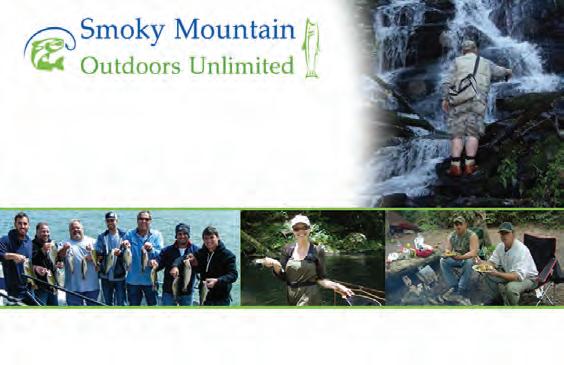
Fontana Lake Fishing Guides – Ronnie Parris, Owner & Head Guide LAKE, CREEK & RIVER FISHING • FLY FISHING • CAMPING
We o er both full and half day trips with the most competitive rates available. All tackle and supplies you will need while you are on your trip is covered by our listed price. 1012 East Alarka Road, Bryson City, NC • 828-488-9711, Cell: 828-736-9471 smokymountainoutdoorsunlimited.com
even-numbered chromosomal complement resulted in viable eggs and sperm.
When a percentage of a population experiences WGD or polyploidy (a random event or perhaps a response to a major environmental or population stressors), a new species comes into existence in a single generation as the polyploid individuals usually cannot reproduce with diploid individuals of the original species.
This rapid mechanism of evolution is one of the drivers of the vast biodiversity on our planet. WGD is more common in plants, invertebrates, and some fish and amphibians. Polyploidy is extremely rare in mammals, and is fatal when it happens within humans. Rainbow trout have 30 pairs or 60 chromosomes, and brown and brook trout have 40 pairs or 80 total chromosomes. WGD events double chromosome number and later chromosomes merge, genes are deleted, and total number of chromosomes can be reduced. Having a large complement of genes provides salmonids the ability to adapt to many life history strategies. As Jeff Goldblum’s character said in the movie Jurassic Park: “Life always finds a way.”

Their service is why you speak English, can vote and can enjoy the freedoms you do! Until next time, blue skies and tight lines!
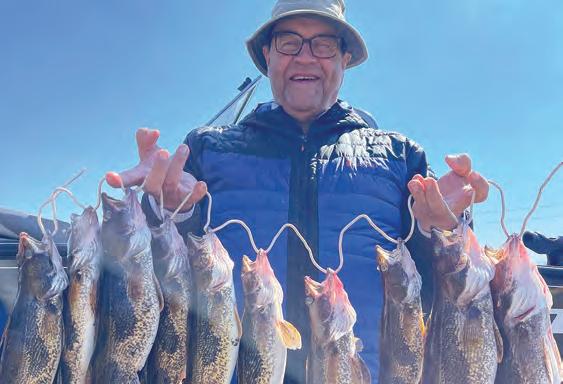
Check out all of our fishing services as well as our exclusive “online” store at www.striperfun.com or call 931-403-2501 to make reservations today.












By Will Schmidt
Sail!sh are known as the fastest !sh on the planet, but they o er more than blazing speed to those who chase them o Florida’s east coast, such as I did on a recent !shing excursion. Spectacular surface bites and astonishing acrobatics make these !sh a coveted catch for even the most experienced anglers. For !rst timers, it’s an adrenaline !led !ght that will stick with you long a er the !sh swims back into the cobalt blue Atlantic. is trip was special for a few reasons. First, we had rising country star Ben Gallaher (IG: @Ben_Gallaher) with us. Ben is an avid outdoorsman and bass !sherman, but he had never caught a saltwater !sh. I was also excited to !sh with some new friends, Capt. Geoge Gozdz of “Unfathomed” (IG: @captgeorgegozdz) and Chris Bishop, VP of marketing at Yo-Zuri (iG: @Yozuri_Lures).
A er just a short run o Port St Lucie, we set our spread, and I could sense any strikes would likely be dramatic. e water was crystal clear and glass at giving us a great view of any action. e !rst !sh in, came crashing into the spread chasing and slashing at a bait with its bill. Unfortunately, as aggressively as it came in, it turned and retreated without eating.
As we reset the spread anticipation grew to !nd Ben’s !rst saltwater adversary. Fortunately, another sail came in a smashed the right rigger. However, it ran right at us, and we were never able to get tight. Undaunted, we set up again. Soon all the baits were nervously darting on the surface. e le atline erupted as the sail slashed, splashed and devoured the bait. Ben was on, and this !sh leapt and twirled with all the acrobatics of a Cirque du Soleil show. ere was still another to eat and moments later we doubled up. Both !sh cooperated with plenty of arial antics and a er a good !ght we had both !sh to the boat. To say Ben was pumped to land his !rst bill!sh is an understatement. Amped up with adrenaline and ready for more he could only beam with an ear-to-ear grin and say “let’s go!”
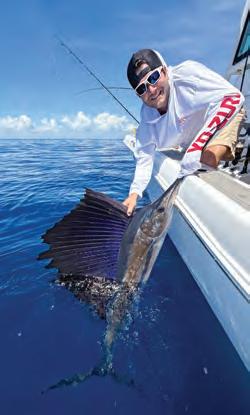
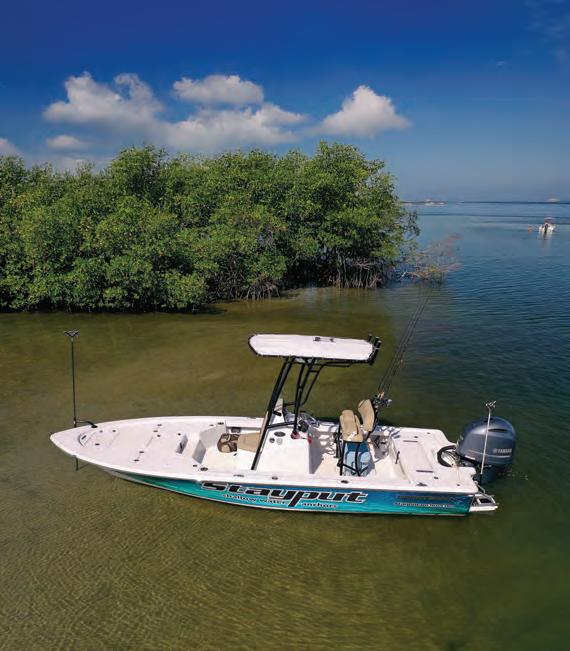


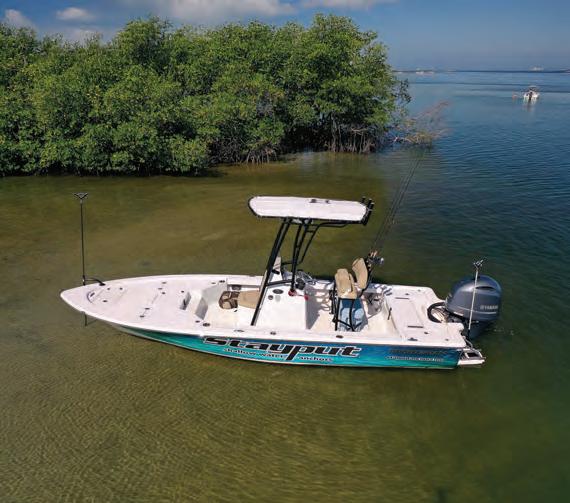







Fall !shing o of Port St Lucie o ers warm water and a hot bite without having to battle high winds and cold temperatures o en associated with winter sail!sh !shing in Florida.. Moreover, it’s not di&cult at all. We were simply bump trolling large, bridled thread!ns. Bridling helps the bait last longer and doesn’t allow for the hook to turn into the thread!n causing a missed strike. Our tackle was medium Penn Carnage rods with Authority reels lined with Yo-Zuri Super Braid topped with Yo-Zuri’s Disappearing Pink Fluorocarbon leader. ese setups gave us the sensitivity to feel the “eat” and the stealthiness to fool even the most cautious of !sh in these clear conditions. On your next trip don’t rush past these exciting sails, stop for some fun acrobatic action.
Will Schmidt is a seasoned tournament angler who has been writing about shing for more than two decades. Follow Will on Instagram @saltynstrong.



It’s no fsh tale when you run with a John Deere. You can get everything done faster and easier, so you get more time on the water. Plus, our special offers make them the catch of the day.




Anglers from around the world come to the U.S. Virgin Islands to !sh our incredible turquoise waters for trophy blue marlin, black!n tuna, wahoo and mahi-mahi. And with no passport required for U.S. citizens, it’s easy to plan your next !shing trip. Whether you want to set o on a crewed charter complete with a professional captain or prefer to simply cast a line from one of our scenic white-sand beaches, get ready to reel in the big one. Plus, many out!tters can customize your trip to include thrilling underwater activities like snorkeling.
O the island of St. Croix choose your own adventure, whether you’re looking to !sh o shore for mahi-mahi, wahoo, king!sh, tuna and blue marlin, or nearshore for tarpon, snapper, mackerel, rainbow runner and jacks. Seasoned crews who have been !shing the waters of USVI for decades will take you on customizable charters in search of catching your trophy !sh of a lifetime. Some out!tters o er complimentary !sh cleaning services, so all you have to do is throw your coveted catch on the grill or in the pan!
From St. John, troll for big game !sh—blue marlin, sail!sh, tuna, mahi-mahi and wahoo—on an o shore charter. Opt for a nearshore charter to catch bonito, barracuda, rainbow runner, snapper and
sharks. Or join an inshore bottom !shing trip to cruise the USVI’s deep-water reefs. Whether you’re an experienced angler or a novice needing some guidance, you’ll !nd an out!tter equipped with all the top-of-the-line !shing gear you’ll need for a successful day at sea.
About 20 miles north of St. omas is the North Drop, an area unparalleled for its big game !sh. Book a deep-sea !shing charter and sail over to this corner of the Caribbean that boasts more blue marlin bites per boat than any other place in the world. Half-day to 10-hour o shore bait !shing charters are ideal for adventurous anglers eager to experience the island’s famous North and South Drops. A mix of trolling and live baiting makes for mega catches, with yellow!n tuna, wahoo, mahi-mahi and blue marlin the most common catches of the day.

Surrounded by pristine blue waters, it’s no surprise that fresh seafood is a delicious part of nature’s bounty in USVI. You’ll !nd plenty of seafood-focused restaurants, from elegant !ne dining to laid-back waterfront eateries. Some out!tters even o er a stop at a seaside restaurant as part of their !shing excursions.







When the leaves start to turn and the water temps dip, bass anglers know what time it is—the fall feed. Bass are chasing bait like crazy, and it’s one of the best times of year to put big !sh in the boat. e trick is knowing what to throw as the season shi s. Here are !ve proven fall baits that will help you stay on the bite no matter what the lake throws at you.
Spinnerbait: Few baits scream “fall” like a spinnerbait. When the wind picks up and shad push shallow, it’s hard to beat a double willow blade ashing through the chop. e ash and thump imitate a school of eeing bait!sh, and hungry bass can’t resist. Target windy points, creek mouths, and shallow ats anywhere the bait’s getting pushed around.
Lipless Crankbait: is one’s all about covering water. Fall bass are constantly on the move, and a lipless crank lets you !nd ’em fast. Burn it over grass, rip it free when it hangs up, and hold on! at reaction bite is what fall !shing’s all about. Red or chrome patterns are money this time of year, especially when bass are chasing shad.
Jerkbait: Once the water clears and the temps drop into the 60s, it’s jerkbait season. Work it with a twitch-twitch-pause cadence, and you’ll mimic dying bait!sh to perfection. is lure shines around suspended bass that hang
o points or creek channels.
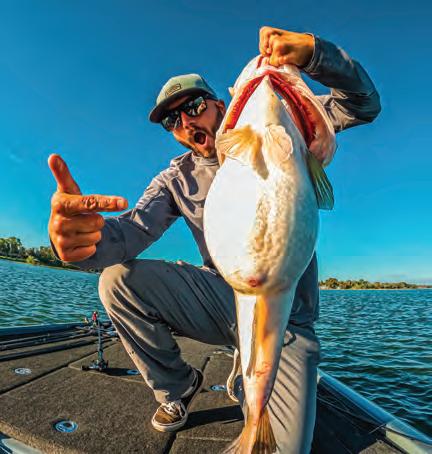

RJust be patient. Sometimes the bite comes right when you least expect it, on that long pause. Squarebill Crankbait & Swimbait: To round out your fall lineup, keep a squarebill and a swimbait on deck. A squarebill is your go-to for shallow cover stumps, rocks, laydowns, anywhere bass are ambushing bait in the backs of creeks. Meanwhile, a so or hard-bodied swimbait is ideal when you’re around big !sh feeding on larger forage. Slow-roll it through bait schools or along creek channels for some of the biggest bass of the year.
Fall is all about !nding the bait, and these !ve lures all mimic shad in their own way. Whether you’re slow-rolling a spinnerbait through wind-blown banks or ripping a lipless crank across a at, the !sh are feeding and it’s your job to get in on the action. Grab a few of these baits, follow the shad, and enjoy one of bass !shing’s most exciting seasons!
Tyler Woolcott is a professional tournament angler and guide. Check out his website at www.tylerwoolcott shing.com.

ed!sh are one of the most sought a er game !sh by inshore !shermen from Texas to the Carolinas. ey are great !ghters; they are great tasting; and they are perfect for sight !shing because they love super shallow water. Red!sh are part of the drum family and have four nostrils. is tells us that scent is their chosen sense while searching for food in dark and murky water.
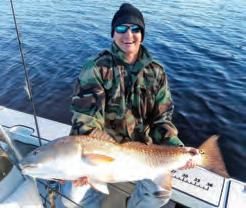
e best red!sh lure that I have ever used is the 3-inch Berkeley Gulp! Shrimp. Berkeley Gulp! products are the smelliest baits that I have ever smelled and red!sh love them. ere are probably other stinky baits that work, but I haven’t found one that is comparable to Gulp! products. e best colors are anything with brown and gold glitter. Rootbeer and new penny are the best choices. e second best lure for catching red!sh is the gold or copper weedless spoon. ese are great search baits when you cannot see the red!sh. A slow retrieve with almost constant contact with the bottom is the way to !sh these lures. ese lures are exceptional for casting. ey cast a mile and let you cover a lot of water as you search for the schools of red!sh in the shallows.
e third best lure for red!sh are 3- and 4-inch paddletails rigged weedless. is is another great search bait for covering large areas of water. You will want to retrieve your paddletail in a similar way to your spoons. Make sure to bounce it o the bottom as you slowly retrieve it.
Contact Capt. Mike Smith, owner of Fish Your Ass O Charters, at (561) 339-2317, contact@ shyourasso .com or shyourasso .com.


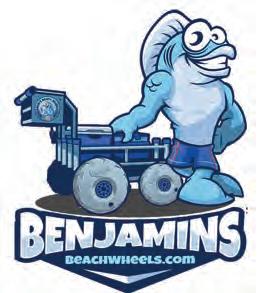


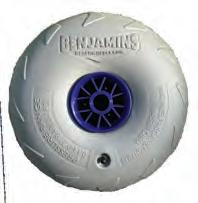


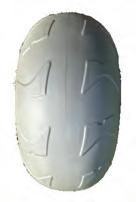

“I never expected it to be so beautiful that it takes your breath away.”
— Kaya C., on Stauer Opals
In a quaint village, nestled between rolling hills, lived a young woman with a deep appreciation for gemstones. Her grandmother gifted her a delicate cross pendant adorned with opals. "e opals shimmered with a mesmerizing play of colors, reflecting hues of blues, greens, and fiery oranges. Her grandmother shared the legend of the opals, believed to bring hope, purity, and luck to those who wore them.
Using this story as inspiration, Stauer brings you the Opal Spirit Cross Pendant. With over 2 total carats of Kyocera lab-created opals set in .925 sterling silver encased in yellow gold, this pendant is a radiant celebration of beauty and craftsmanship. Each opal captivates with a kaleidoscopic dance of fiery oranges blending into oceanic blues, streaked with flashes of vibrant green that seem to come alive with every movement. "e shimmering opals are skillfully arranged to create an enchanting, otherworldly glow, embodying the spirit of hope and harmony. "is breathtaking combination of color and craftsmanship is available as a limited availability of only 930 pieces, making it a rare and treasured addition

to your jewelry collection. Plus, when you order today, you’ll receive the Opal Spirit Cross Pendant at an impossible price of just $59 normally $149!
Don’t miss your chance to own this exclusive tribute to timeless elegance and meaningful symbolism.
Jewelry Speci!cations:
• Pendant: 2 ½ ctw. Kyocera lab opals and DiamondAura® accents. Yellow gold-finished .925 sterling silver setting
• Chain: 18" gold-clad .925 sterling silver chain
Opal Spirit Cross Collection

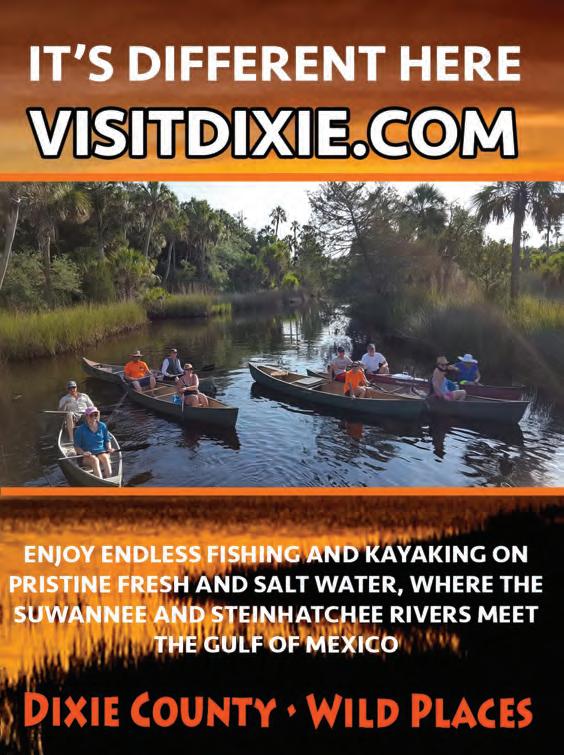


ovember is almost a completely unique month of the year. We’ll start getting the !rst real cold fronts, and this will pile the bait on temp breaks. Structure on the bottom will certainly hold the grouper and snapper on the bottom, but pay attention to the recorder and the marks in the mid water column. ese marks can be a number of the targets we’re looking for. Black!n are a given during the month of November, but it’s “go time” for wahoo and yellow!n. e bait can stand colder water than the pelagics. is is one of their biggest defensive strategies, and why you should have a (realistic) jig ready that can !sh 75-150 feet deep around the bait balls because the surface water will likely be as much as a few degrees warmer that the surface water due to the cold wind blowing overhead. Keep live baits out on circle hooks and ourocarbon and try to get some lower in the water column. ese live baits are black!n bombs ready to go o , but I am always drawn to the bottom in search for the grouper and snapper. Some of these same live baits or frozen cigs and sardines on the correct jigs (hint, hint) are irresistible to the !sh I’m really looking for. I want the big grouper and snapper bite. When you !sh the correct baits using the correct presentation, you’re not asking them to eat it, you’re MAKING them eat it! BAM! is is also African pompano candy. e jig in the mid to lower part of the water column is deadly, but if there’s no bites !shing it deeper and deeper all the way to the bottom, bring it up to the surface and repeat the process.
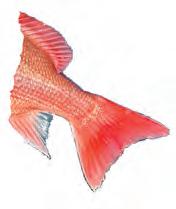
A trolling motor will really help in this controlled dri , keeping the bow forward into the wind and/or current. is will keep the light line out back and the baits on or near the bottom slightly back depending on the current. is is the bottom line: bag the trolling crap, post up on stacks of bait with dedicated crew for the light line and/or jig and dedicated crew on the bottom to generate groceries in the cooler. is is my kind grocery shopping.
Learn the drill of how to !sh the entire water column nice and quiet with beautiful baits and tactics for results. Dress with proper !tting foul weather gear and take plenty of photos and videos you can enjoy for years to come.
Learn more from Tim Barefoot on his YouTube channel and at barefootcatsandtackle.com.
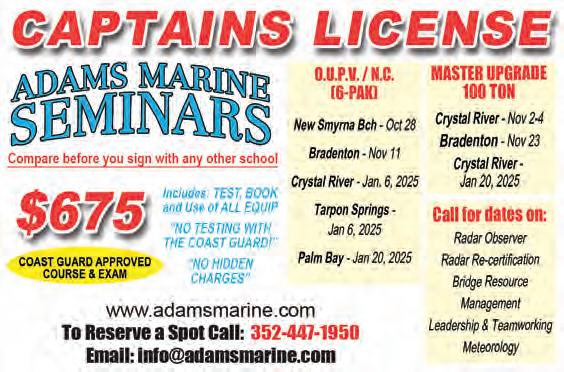
Spot Call: 352-447-1950
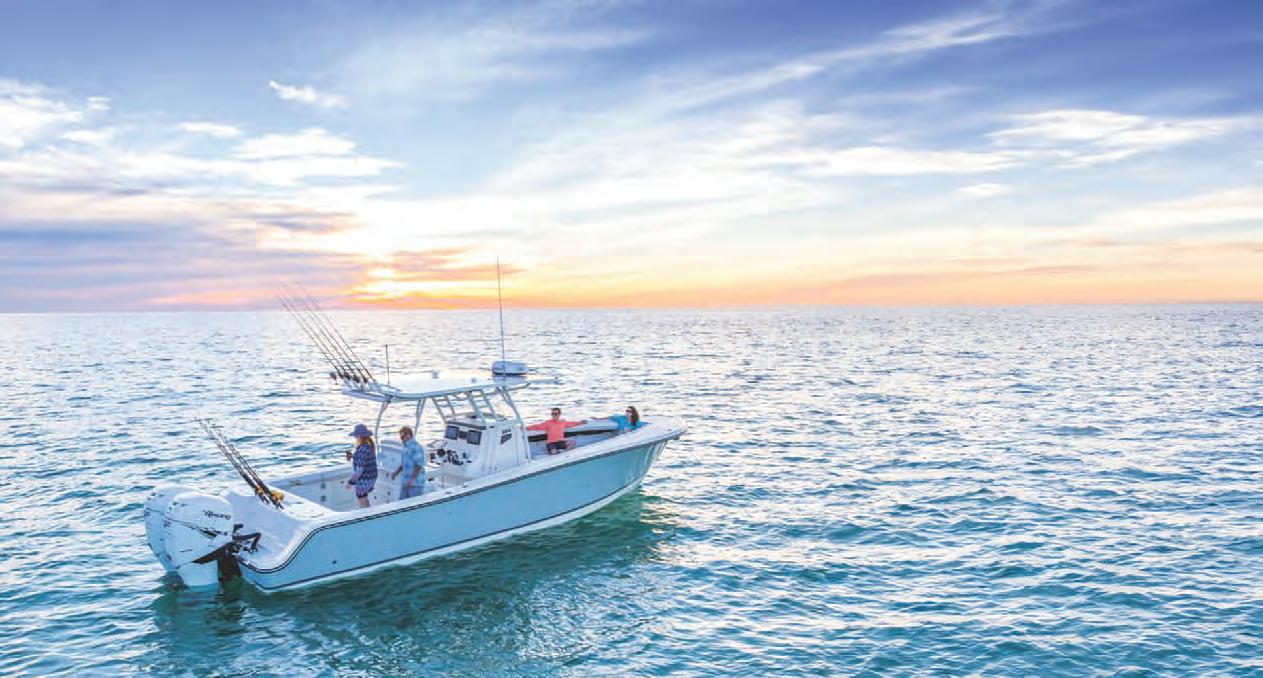


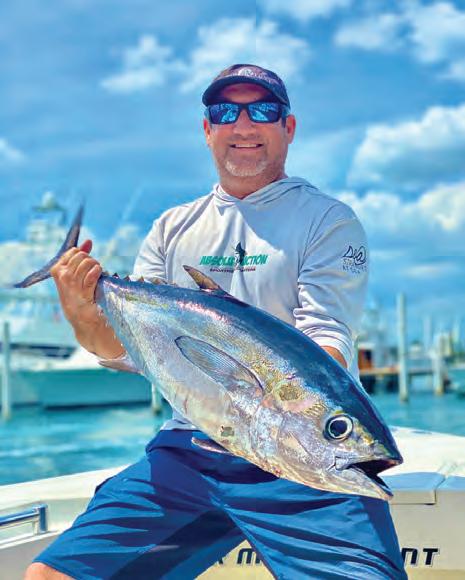





It was a warm summer afternoon and my wife and I were mingling with the best of them. The occasion was a 1920s-themed party, and everyone was dressed to the nines. Parked on the manse’s circular driveway was a beautiful classic convertible. It was here that I got the idea for our new 1920s Retrograde Watch.
Never ones to miss an opportunity, we carefully steadied our glasses of bubbly and climbed into the car’s long front seat. Among the many opulent features on display was a series of dashboard dials that accentuated the car’s lavish aura. One of those dials inspired our 1920s Retrograde Watch, a genuinely unique timepiece that marries timeless style with modern technology.

With its remarkable retrograde hour and minute indicators, sunburst guilloche face and precision movement, this design is truly one of a kind. What does retrograde mean? Instead of displaying the hands rotating on an axis like most watches, the hands sweep in a semicircle, then return to their starting point and begin all over again.

Retrograde watches by the big brands can set you back thousands; one recent offering from a big French fashion house is selling for more than $150,000! But because we’ve designed the 1920s Retrograde Watch in-house, we can offer it to you for just $99!
This watch is so wildly popular with our customers that we’re actually concerned about running out; we only have 937 729 left for this ad!
Join more than 1 MILLION smart people who love stauer watches

Watch Specifications:
• Precision movement
• Stainless steel case, caseback and crown
• Retrograde hour and minute indicators
• Water-resistant to 5 ATM




• Brown genuine leather band
• Fits wrists up to 8"
1920s Retrograde Watch
$399 $99* + S&P Save $300


*Special price only for customers using the offer code.





“An elegant and exciting timepiece that every collector will love.”
— George Tomas, internationally renowned watch expert



“[A] unique and beautiful timepiece.”
— Carlos C., Los Banos, CA




